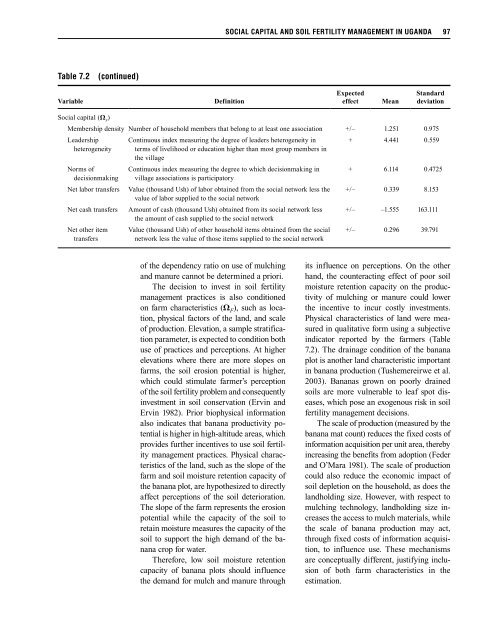An Economic Assessment of Banana Genetic Improvement and ...
An Economic Assessment of Banana Genetic Improvement and ...
An Economic Assessment of Banana Genetic Improvement and ...
Create successful ePaper yourself
Turn your PDF publications into a flip-book with our unique Google optimized e-Paper software.
SOCIAL CAPITAL AND SOIL FERTILITY MANAGEMENT IN UGANDA 97<br />
Table 7.2 (continued)<br />
Variable<br />
Definition<br />
Expected<br />
effect<br />
Mean<br />
St<strong>and</strong>ard<br />
deviation<br />
Social capital (Ω s )<br />
Membership density Number <strong>of</strong> household members that belong to at least one association +/– 1.251 0.975<br />
Leadership<br />
heterogeneity<br />
Continuous index measuring the degree <strong>of</strong> leaders heterogeneity in<br />
terms <strong>of</strong> livelihood or education higher than most group members in<br />
the village<br />
+ 4.441 0.559<br />
Norms <strong>of</strong><br />
decisionmaking<br />
Net labor transfers<br />
Net cash transfers<br />
Net other item<br />
transfers<br />
Continuous index measuring the degree to which decisionmaking in<br />
village associations is participatory<br />
Value (thous<strong>and</strong> Ush) <strong>of</strong> labor obtained from the social network less the<br />
value <strong>of</strong> labor supplied to the social network<br />
Amount <strong>of</strong> cash (thous<strong>and</strong> Ush) obtained from its social network less<br />
the amount <strong>of</strong> cash supplied to the social network<br />
Value (thous<strong>and</strong> Ush) <strong>of</strong> other household items obtained from the social<br />
network less the value <strong>of</strong> those items supplied to the social network<br />
+ 6.114 0.4725<br />
+/– 0.339 8.153<br />
+/– –1.555 163.111<br />
+/– 0.296 39.791<br />
<strong>of</strong> the dependency ratio on use <strong>of</strong> mulching<br />
<strong>and</strong> manure cannot be determined a priori.<br />
The decision to invest in soil fertility<br />
management practices is also conditioned<br />
on farm characteristics (Ω F ), such as location,<br />
physical factors <strong>of</strong> the l<strong>and</strong>, <strong>and</strong> scale<br />
<strong>of</strong> production. Elevation, a sample stratification<br />
parameter, is expected to condition both<br />
use <strong>of</strong> practices <strong>and</strong> perceptions. At higher<br />
elevations where there are more slopes on<br />
farms, the soil erosion potential is higher,<br />
which could stimulate farmer’s perception<br />
<strong>of</strong> the soil fertility problem <strong>and</strong> consequently<br />
investment in soil conservation (Ervin <strong>and</strong><br />
Ervin 1982). Prior biophysical information<br />
also indicates that banana productivity potential<br />
is higher in high-altitude areas, which<br />
provides further incentives to use soil fertility<br />
management practices. Physical characteristics<br />
<strong>of</strong> the l<strong>and</strong>, such as the slope <strong>of</strong> the<br />
farm <strong>and</strong> soil moisture retention capacity <strong>of</strong><br />
the banana plot, are hypothesized to directly<br />
affect perceptions <strong>of</strong> the soil deterioration.<br />
The slope <strong>of</strong> the farm represents the erosion<br />
potential while the capacity <strong>of</strong> the soil to<br />
retain moisture measures the capacity <strong>of</strong> the<br />
soil to support the high dem<strong>and</strong> <strong>of</strong> the banana<br />
crop for water.<br />
Therefore, low soil moisture retention<br />
capacity <strong>of</strong> banana plots should influence<br />
the dem<strong>and</strong> for mulch <strong>and</strong> manure through<br />
its influence on perceptions. On the other<br />
h<strong>and</strong>, the counteracting effect <strong>of</strong> poor soil<br />
moisture retention capacity on the productivity<br />
<strong>of</strong> mulching or manure could lower<br />
the incentive to incur costly investments.<br />
Physical characteristics <strong>of</strong> l<strong>and</strong> were measured<br />
in qualitative form using a subjective<br />
indicator reported by the farmers (Table<br />
7.2). The drainage condition <strong>of</strong> the banana<br />
plot is another l<strong>and</strong> characteristic important<br />
in banana production (Tushemereirwe et al.<br />
2003). <strong>Banana</strong>s grown on poorly drained<br />
soils are more vulnerable to leaf spot diseases,<br />
which pose an exogenous risk in soil<br />
fertility management decisions.<br />
The scale <strong>of</strong> production (measured by the<br />
banana mat count) reduces the fixed costs <strong>of</strong><br />
information acquisition per unit area, thereby<br />
increasing the benefits from adoption (Feder<br />
<strong>and</strong> O’Mara 1981). The scale <strong>of</strong> production<br />
could also reduce the economic impact <strong>of</strong><br />
soil depletion on the household, as does the<br />
l<strong>and</strong>holding size. However, with respect to<br />
mulching technology, l<strong>and</strong>holding size increases<br />
the access to mulch materials, while<br />
the scale <strong>of</strong> banana production may act,<br />
through fixed costs <strong>of</strong> information acquisition,<br />
to influence use. These mechanisms<br />
are conceptually different, justifying inclusion<br />
<strong>of</strong> both farm characteristics in the<br />
estimation.
















